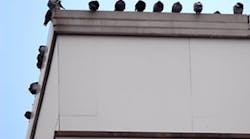It’s been said “preventative maintenance is the best kind of maintenance.” If you routinely check your facilities operational systems and equipment, it will save you time and money. Problems are easier and less expensive to fix the sooner they are noticed. Bird control is no different.
Adding bird control to your routine maintenance checklist is a wise decision, considering the impact birds can make on your building. Bird control can save your company time and money, and bird problems are easier to solve the sooner they are detected.
Most preventive maintenance checklists include roofing, HVAC, lighting, furnaces, cooling towers and electrical systems. Birds can negatively impact nearly all of these areas, so including bird control in your regular maintenance makes sense.
Ignoring bird droppings or nesting materials in these areas can lead to costly cleanup and sometimes even replacement of materials or equipment.
Here is a list of the most common areas birds can damage buildings:
Rooftops
Birds like high perches and choose building ledges and parapet walls to perch on. The build up of droppings in these areas and over the side of the building can negatively impact the buildings aesthetics. Left long enough, bird droppings can stain and corrode building materials. Install physical bird deterrents like bird spikes or electric track systems to keep these areas bird free.
Drainage Systems
Bird droppings and nesting materials can clog drainage systems, leading to pooling water, water damage and leaks. Check drainage systems for signs of nesting birds. It’s much less expensive to clear away bird debris and install a bird deterrent than to fix water damage on a building.
This content is advertiser sponsored:
HVAC units
Birds regularly choose to roost and nest near HVAC units. They provide elements that are inviting to birds, including shelter, rooftop gravel and a continuous water source if the unit is leaking. When birds decide to nest or roost in these areas, not only can they damage the equipment itself, dried bird dropping spores can actually be sucked through ventilation systems putting building inhabitants at risk for disease. Bird droppings carry over 60 transmittable diseases and those with compromised immune systems are most at risk.
Walkways, Stairways, Entryways
The best evidence of a bird problem on your building can be found by looking down. Are there bird droppings present in walkways or entryways? Birds may be sitting under canopies or on rooflines near these areas. Bird droppings can create a slip and fall risk to employees. Many businesses spend money each month power washing these areas. Instead, install bird deterrents to keep the birds away and save on clean up costs.
Windows and Doorframes
Birds like to perch on window ledges, often leaving a build up of droppings and potentially causing a noise disturbance to people inside the building. Check window sills for bird droppings or nesting materials.
Lighting systems
The warmth created by lights and the high perch are the perfect spot for a bird to nest and roost. Nesting materials and a build up of droppings can damage and stain equipment and create a fire hazard. Check lighting systems for evidence of nesting materials.
Exterior Signage
A high perch and shelter from outdoor elements are usually what draws birds to signs. As signs are used to attract customers, the presence of bird droppings or nesting materials may send the wrong message to potential customers.
Loading Docks
Birds are commonly found near loading dock areas where the interior of the building is open on a regular basis. Birds like to nest in rafters, on beams, and sometimes above loading dock rolling doors. Birds in these areas can damage equipment, incoming/outgoing product and make for an unsanitary workspace.
Waste Storage
Free food is all that’s needed to attract pests and birds are no different. If there are outside waste bins around the building it’s important to keep these areas clean and to make sure the bins are always covered. This will prevent gulls, crows and other birds from congregating around the area.
Bird Deterrents Can Help
Bird control products have come a long way since the scarecrow. Today there are several innovative bird control products ranging from simple to complex that can help deter birds from landing or nesting in unwanted areas. Bird control products are chosen depending on the type of bird posing a problem, the area they are in, and the whether the birds are nesting or not. Choosing the right bird control product for the situation is crucial for successfully deterring birds. Bird control companies such as Bird-B-Gone, Inc.® can help guide customers to choose the best deterrent for their situation.
A few common bird deterrents:
Bird Spikes
Bird Spikes are a simple, humane method for preventing large birds such as pigeons, crows and gulls from landing. They are ideal for rooftops, window sills, parapet walls, ledges and other flat or curved surfaces. Bird spikes can be glued or screwed into place and do not harm birds.
Bird Netting
Bird Netting is used as a physical barrier to block birds from entering unwanted areas. Bird Netting is effective for all bird species and works for nesting sites. Bird Netting is ideal for canopies, roof recesses, HVAC units, rafters, eaves and other semi enclosed areas.
Electric Track Systems
Electric track systems emit a slight shock when birds land on their surface. The shock will not harm birds, but will condition them to avoid the area. Electric track bird deterrents are effective for small and large birds and are ideal in high profile areas where aesthetics are a concern. The tracks only sit about a ½” above the surface.
Bird Repellers
Bird repellers, such as Bird Spiders, Solar Bird Repellers and Repeller 360 units, are used to keep birds from landing in concentrated areas. Common places of use include the tops of HVAC units, signs, lights, roof caps and other areas. These units usually rotate or move in the mind to deter birds using motion.
Sound Deterrents
Sonic bird deterrents – or bird deterrents that play sounds of recorded bird calls can be effective for large open spaces such as parking lots, rooftop areas and more. If you’re considering a sound deterrent for birds, make sure its not silent or ultrasonic; birds hear on the same level as humans and are not affected by ultrasonic bird devices.
Most bird problems are easiest to solve as soon as they are detected. The longer birds are allowed to inhabit an area, the more territorial they will become and the harder it will be to get them to leave.
Installing bird deterrents ranges from the simple to the complex. Most maintenance departments are able to install items such as bird spikes and other physical bird deterrents, but if the birds are nesting and netting is required, you may need to seek outside help for your bird problem.
If you don’t have the time or resources to handle the bird problem in house, ask the pest control company servicing the building for general pests if they do bird control. Most pest control companies deal with pest birds and will be able to clean nesting or roosting sites and install bird deterrents. Bird control companies such as Bird-B-Gone, Inc. also work with “authorized installers” – professionals trained and skilled in bird control.
Meredith Walako has worked with Bird-B-Gone for 10 years in sales and marketing. Bird-B-Gone, Inc. is the nations leading manufacturer of effective and humane bird control products. To learn more visit http://www.birdbgone.com or call 1-800-392-6915


